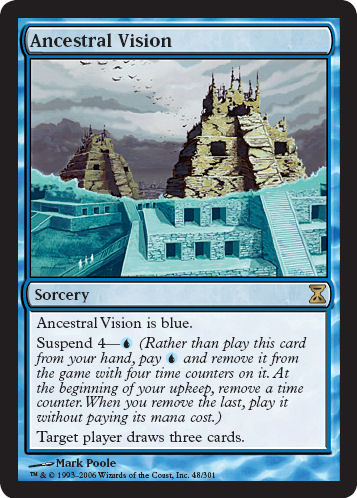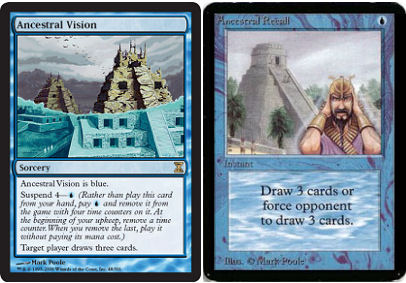Many writers at MagictheGathering.com like to have a big build-up towards their Time Spiral preview cards. I’m not one of those guys, and plus I’m too excited to go a few thousands words without sharing our Time Spiral preview card with you. Without further adieu, I present Ancestral Vision!

Y’all still with me? Groovy! Yes, Ancestral Vision is as good as it looks. For just a single Blue mana, you get to draw three cards. Sure, you don’t get those cards for a few turns, but what Blue mage wants to tap out on turn 5 anyhow?
Blue Mage: “I have tapped out to play Concentrate/Tidings”
Red Mage: “Raging Goblin, pitch two Myojin of Infinite Rage to two Blazing Shoals, kill you.”
Man, imagine this scenario with Ancestral Vision:
Blue Mage: “I spent my first turn tapping my Island so that I can draw three cards later on, without the need to tap out.”
Red Mage: “Alas! You have five mana up, and I have no hope of breaking through your impenetrable fortress of countermagic. Damn you, Blue Mage!”
All jokes aside, some people may be put off by the suspend cost of Ancestral Vision. Heck, some people might even be put off by suspend, since they don’t know what it does. Let me give you a quick rundown:
When you play the suspend cost of a card, you remove that card from the game with X Time counters on it. In the case of Ancestral Vision, you’d need to spend a Blue, and it’d get removed with four Time counters. At the beginning of each of your upkeeps, you remove a Time counter from your suspended card. Once there are no counters left on the card, you get to play the card for free — i.e., if you suspend Ancestral Vision on turn 1, you remove a counter turns 2, 3, 4, and 5, and then draw three cards during your fifth turn’s upkeep.
Say you draw Ancestral Vision later in the game — is it useless? Well, it’s definitely better earlier than later, but it will still break a control match in half — the Suspend ability doesn’t use the stack, so it can’t be countered. So, for instance, if you and your opponent each have a full grip of countermagic, you can still Suspend Ancestral Vision without him getting a chance to counter it. His opportunity will come four turns later — but you’ll only have taken a single, lonely Island to suspend your spell in the first place, which will not really leave you open to retaliation.
You know what else Ancestral Vision does? It allows you to aggressively mulligan like virtually no card before. Is your opening hand pretty crappy? Try to mulligan into an Ancestral Vision, and you’ll be back up in cards in no time at all! Playing a combo deck? Bank an Ancestral Vision and a Lotus Bloom, and you’ll have all the mana and cards you need to go off, come turn 5!
I got the opportunity to ask some questions to several Wizards of the Coast R&D members, regarding Ancestral Vision. Here’s what they had to say:
Question: What art direction did you give to Mark Poole for this card? It is very much a homage to the pyramids in the background of the original Ancestral Recall!
Answer (from Jeremy Jarvis): It is certainly no accident that Ancestral Vision hearkens visually to Ancestral Recall! The art description asked Mark Poole to create an image quoting the same style pyramids as he did in Recall, but on top of that, to show the image in the throes of the “Suspend” cue, with “real time” pushing through the stylized blue time barrier. Mark took it a step further and showed the pyramids and environment at a different point in time through the delay barrier, with the scene emerging weathered and worn as it arrives in the present. He really helped sell the idea of “time with a blurry edge” between past and present… Big love to Mark for the job he did here!

Question: Why make this card uncastable through normal means? Why not give it a cost of UU3 or UU4, so that it can be normally played without suspend?
Answer (from Aaron Forsythe): We liked the idea of having suspend cards with effects so powerful that the only way to use them was to suspend them, and made a cycle of them. Giving the card no cost makes it feel more like the original Ancestral, whereas tacking on a cost of 3UU or 4UU would make it feel, at first glance, more like bad Concentrate or something. The gimmick is worth far more than adding functionality.
Question: How do you feel Ancestral Vision compares to the following Standard-legal cards?
Compulsive Research
Counsel of the Soratami
Flow of Ideas
Perilous Research
Sift
Tidings
Train of Thought
Answer (from Aaron Forsythe): We tend to not print the power-level of cards on the cards themselves so that our players can have the enjoyment of determining what’s better than what.
Note from Ben: Aaron might not be willing to answer this question, but I’ll take a crack at it. If you draw Ancestral Vision within the first two turns of the game, it’s better than every card in this list, except Compulsive Research — and then there’s room for debate. If you draw it later in the game, it will be conditionally better/worse than Tidings/Train of Thought/Perilous Research, depending on the match you are playing — if it’s a control mirror, chances are Ancestral Vision will be better for the reasons outlined a few paragraphs back. If you’re facing down a horde of Goblins or Elves, good luck!
Special Note from Ben: If you suspend Ancestral Vision on the first turn, your opponent will never Duress it out of your hand! Take that, Fact or Fiction!
For all you Blue mages out there, enjoy Ancestral Vision — it is going to be heartily used and reused in the years to come. This is the real deal — a draw spell that, I daresay, is quite ridiculous. Think of it as an investment at the bank — you pay only one Blue, and you accrue three cards just a few turns down the road.

Ancestral Vision, a.k.a. please daddy, don’t hit the Blue mage with your chair.

